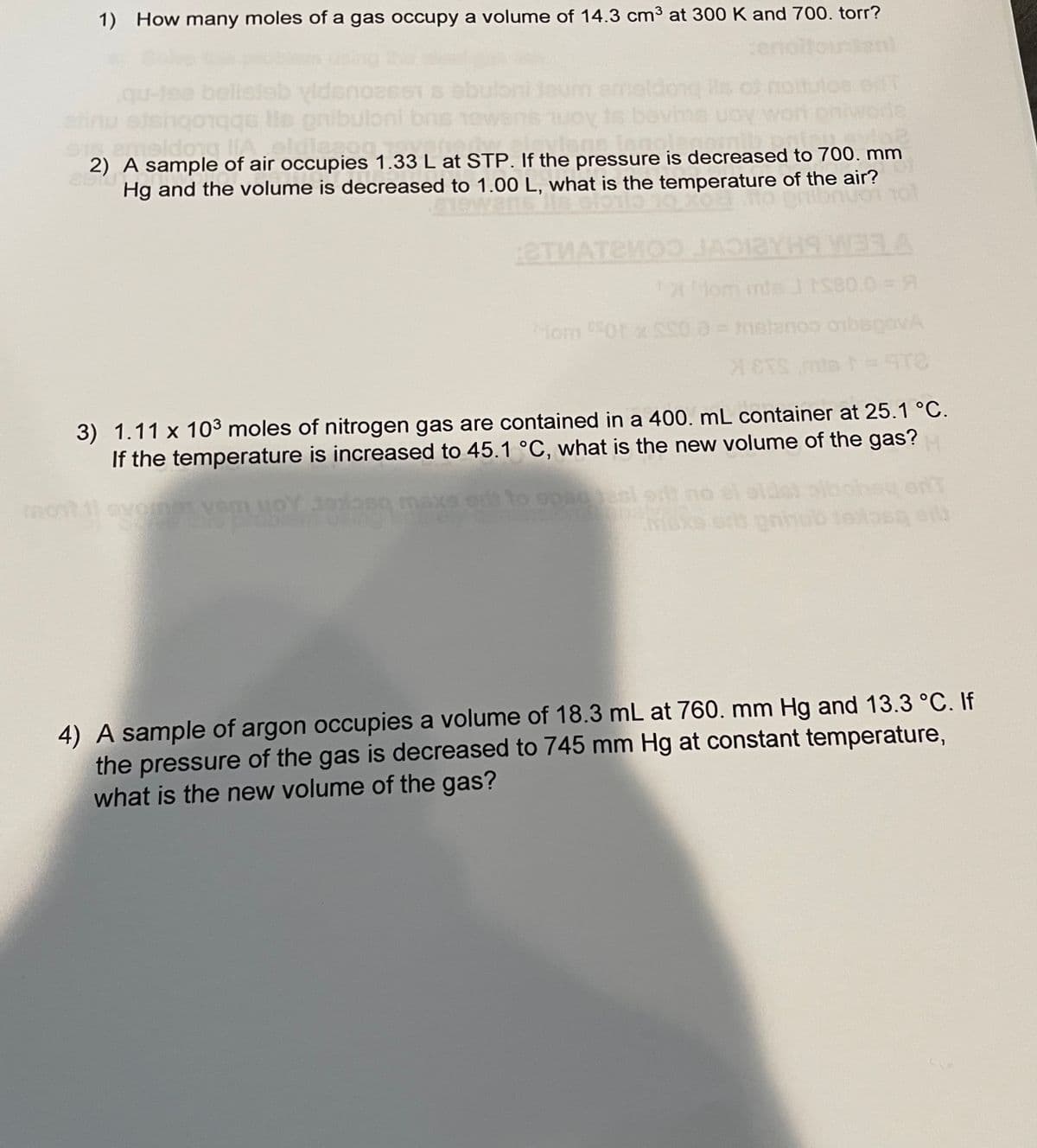Chemistry: An Atoms First Approach
2nd Edition
ISBN:9781305079243
Author:Steven S. Zumdahl, Susan A. Zumdahl
Publisher:Steven S. Zumdahl, Susan A. Zumdahl
Chapter8: Gases
Section: Chapter Questions
Problem 100E: The oxides of Group 2A metals (symbolized by M here) react with carbon dioxide according to the...
Related questions
Question
Please answer step by step

Transcribed Image Text:1) How many moles of a gas occupy a volume of 14.3 cm3 at 300 K and 700. torr?
qu-tea
belisieb videno
ouspp
ame
Hs o
atir
etshgbb lle pnibuloni
emeldong lA.eldlea
2) A sample of air occupies 1.33 L at STP. If the pressure is decreased to 700. mm
Hg and the volume is decreased to 1.00 L, what is the temperature of the air?
ETWATEWOO
JABYHS WE1A
Mom 0r x tanos onbegovA
VA
3) 1.11 x 103 moles of nitrogen gas are contained in a 400. mL container at 25.1 °C.
If the temperature is increased to 45.1 °C, what is the new volume of the gas?
mont
to
cnnob telosa e
4) A sample of argon occupies a volume of 18.3 mL at 760. mm Hg and 13.3 °C. If
the pressure of the gas is decreased to 745 mm Hg at constant temperature,
what is the new volume of the gas?
Expert Solution
This question has been solved!
Explore an expertly crafted, step-by-step solution for a thorough understanding of key concepts.
This is a popular solution!
Trending now
This is a popular solution!
Step by step
Solved in 2 steps

Knowledge Booster
Learn more about
Need a deep-dive on the concept behind this application? Look no further. Learn more about this topic, chemistry and related others by exploring similar questions and additional content below.Recommended textbooks for you

Chemistry: An Atoms First Approach
Chemistry
ISBN:
9781305079243
Author:
Steven S. Zumdahl, Susan A. Zumdahl
Publisher:
Cengage Learning


Chemistry
Chemistry
ISBN:
9781305957404
Author:
Steven S. Zumdahl, Susan A. Zumdahl, Donald J. DeCoste
Publisher:
Cengage Learning

Chemistry: An Atoms First Approach
Chemistry
ISBN:
9781305079243
Author:
Steven S. Zumdahl, Susan A. Zumdahl
Publisher:
Cengage Learning


Chemistry
Chemistry
ISBN:
9781305957404
Author:
Steven S. Zumdahl, Susan A. Zumdahl, Donald J. DeCoste
Publisher:
Cengage Learning

Introductory Chemistry: An Active Learning Approa…
Chemistry
ISBN:
9781305079250
Author:
Mark S. Cracolice, Ed Peters
Publisher:
Cengage Learning

Chemistry: Principles and Practice
Chemistry
ISBN:
9780534420123
Author:
Daniel L. Reger, Scott R. Goode, David W. Ball, Edward Mercer
Publisher:
Cengage Learning

Chemistry: The Molecular Science
Chemistry
ISBN:
9781285199047
Author:
John W. Moore, Conrad L. Stanitski
Publisher:
Cengage Learning